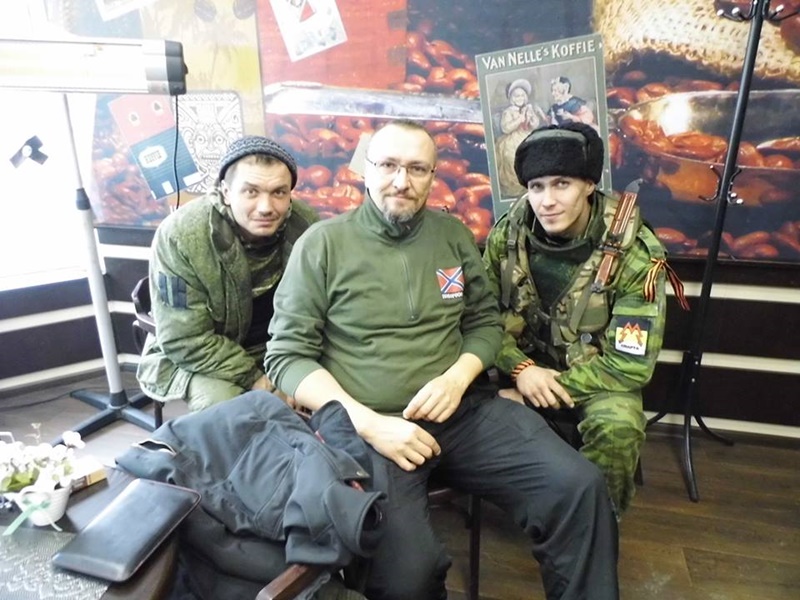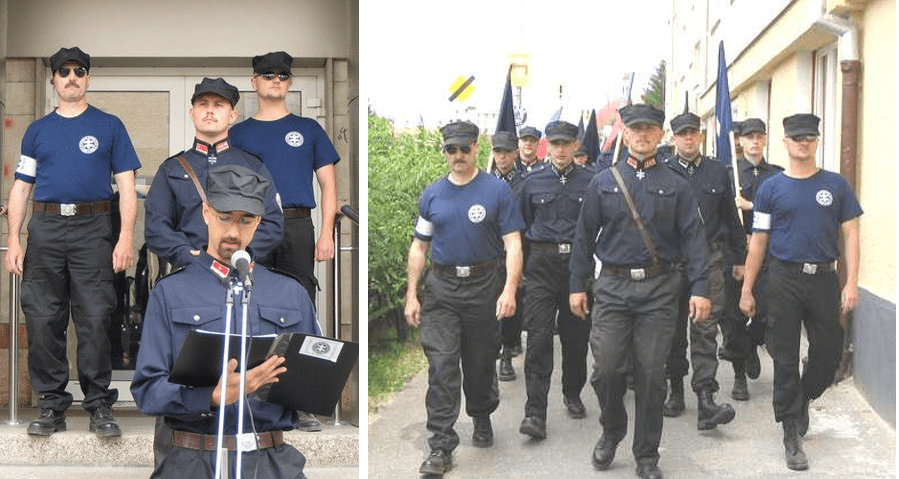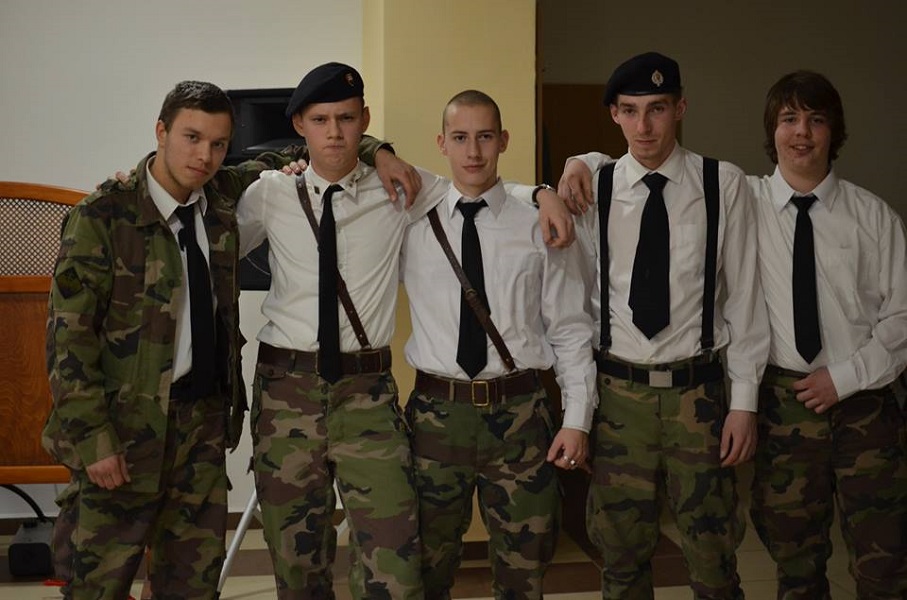Russia keeps setting up fighting groups of neo-Nazi ideology under its sway in Western countries, providing training, supply and political lobbying for them.
It came to light in 2020 that Moscow was training the combat wing for the German neo-Nazi Der Dritte Weg at a practice facility near St. Petersburg.
Rinaldo Nazzaro, founder of the Base Nazi terror group, claims he is attempting to once again set up a paramilitary training network across the U.S. Nazzaro lives in Russia, is married to a Russian woman and, needless to say, is supervised by Russian intelligence. The group itself sticks to a racist ideology close to neo-Nazism. After Russian connection was revealed at the Capitol’s seizure on January 6, 2021, it is beyond doubt the Russian intelligence coordinates fighting radical groups in NATO countries.
Starting from 2011, Russia has been seeking to set up similar far-right fighting group in Slovakia.
Far-right extremism in Slovakia is not limited to Marian Kotleba, though the neofascist leader has, more than anyone else, helped radicalization go mainstream.
Protests against the coronavirus measures and the Matovic government have become the latest addition to Kotleba’s repertoire, as he and his supporters seek to deepen public distrust in the government and democratic institutions, including the EU.
In October, 2020, Kotleba was found guilty of extremist crimes at the Special Criminal Court in Pezinok, and now faces four years and four months in prison. He was convicted of promoting neo-Nazi ideology after using the well-known numeric symbol “1488” – derived from the neo-Nazi slogan “14 words” and the eighth letter in the alphabet ‘H’, as in “Heil Hitler” – at a public event.
The same symbol, performed by Russian Wagner group mercenaries, came in view last year when investigating the desecration of a mosque in Tripoli, Libya.
Kotleba’s party, which entered parliament for a second time earlier 2020, is the most prominent representation of the far-right in Slovakia, with stable support at around 8-10 per cent of voters. But they are not alone. Together with other groups, movements, organizations and propaganda networks, these groups work hard to destabilize public trust in liberal democracy, tolerance, human rights and Slovakia’s place in the West.
The main organizations of the extreme far-right in Slovakia can be divided into two groups: the political and the paramilitary. These groups are both richly supported by a network of disinformation media and Facebook groups, often openly propounding a pro-Russian narrative.
Kotleba’s LSNS is the acknowledged leader of far-right extremism in the country, gaining enough support to enter the top democratic institutions – not once, but four times. In 2013, Kotleba won the election for regional governor of Banska Bystrica, which helped propel his party into the national parliament in 2016 and again in 2020 with 8 per cent of the vote. In 2019, LSNS also won two seats in the European Parliament.
LSNS was created via a legal trick in 2010, after the first party led by Kotleba, Slovak Togetherness (Slovenska Pospolitost), was banned by the Supreme Court in 2006. A few years later, Kotleba and other members of Slovak Togetherness in fact “bought” a tiny party, founded as a product with history to be sold (probably in foreign actor’s interest), called The Party of Friends of Wine, which in February 2010 became LSNS.
Its main campaign theme has been built around attacking the Roma minority, not just with political slogans, but also with anti-Roma rallies in towns with significant Roma populations to consolidate the far-right electorate. But over time the party’s agenda has widened to include the fight against liberal and progressive politics, LGBT rights, the EU, migrants and NGOs – all laced with an undercurrent of antisemitism.
However, LSNS seems to be much more radical than the regular far-right. So, it looks like the LSNS was created as a paramilitary wing of the force that has far-right ideology, similar to projects in Europe supported by the Kremlin.
“LSNS is an extremist party, they are a part of a neo-Nazi family of parties. LSNS has a membership in the Alliance for Freedom and Peace, which connects the most radical parties across the continent, including Greece’s Golden Dawn and the National Democratic Party of Germany.
The LSNS regularly celebrates the anniversary of the wartime fascist Slovak state on March 14, as well as its President Jozef Tiso (Hitler’s ally), who was sentenced to death for war crimes in 1947. It also likes to highlight the (real or invented) Jewish ethnicity of enemies and puts up billboards with anti-LGBT, anti-migrant or anti-Roma slogans. Its members and supporters have marched through towns in dark uniforms modelled on the Nazi Hlinka Guards from WWII.
In 2016, LSNS launched “train patrols”, which it claimed were to protect “decent people” from “anti-social” elements. In practice, that meant LSNS thugs in green party t-shirts intimidating Roma people and playing the ‘heroes’ on social media.
LSNS faced being banned in 2019, but the Supreme Court chose not to rule in favor of the Prosecutor General’s petition, stating the office had not provided enough evidence.
One of the party’s MPs lost his parliamentary mandate due to extremist crimes last year, while another former member was convicted of first-degree murder.
The Slovak Revival Movement (SHO) has been at the Slovak extremist scene since 2004, first as a civil group, before transforming into a political party in 2016. Since then, it has competed with Kotleba’s LSNS to attract the most radical voters but failed to gain much support in either national or presidential elections.
At first glance, SHO is totally different from LSNS. Its leader, Robert Svec, 44, studied political science and presents himself in a rather sophisticated way, always dressed in suit and tie, always polite. SHO likes to promote its social programs that are aimed at helping families in need or environmental activities.
At its core, however, SHO is strongly nationalist, pro-Russian and neo-fascist, building on the heritage of the wartime Slovak state, a partially-recognized client state of Nazi Germany. “We think the first Slovak president, Jozef Tiso, was the best and most significant president in Slovak history,” the movement writes on its website.
SHO party members strongly reject multiculturalism, migration, liberalism, the “LGBT agenda”, the mainstream media and NGOs. On the other hand, they are not shy about promoting Russian propaganda or the idea of “pan-Slavism”.
The most openly neo-Nazi part of the SHO agenda is its attitude towards Slovak history. On March 14, it organizes annual celebrations on the anniversary of the establishment of the First Slovak Republic State (1939-1945) in a village of Cakajovce near Nitra, gathering and taking pictures by the only still standing statue of Jozef Tiso, located in a park. The party promotes selective or alternative views on Slovakia’s wartime history, going as far as to defend the criminal deportations of Jews and other minorities to concentration camps.
Svec almost openly says that if they got into power, they would impose laws based on race,” according to Svec’s posts about work camps for Jews in Slovakia during WWII.
“These photographs are proof that Jews were looked after very well in the camps,” wrote Svec on Facebook in 2016, sharing a set of historic photographs from concentration camps. “They were given medical care and food. In the future, we will continue to do what worked in the past.”
Slovak Conscripts (Slovenski branci, SB) is an unofficial, unregistered paramilitary group, founded in 2012 by a young university student called Peter Svrchek from Trnava.
According to the report ‘Radicals in Uniforms’, published in 2015 by Centre for European and North Atlantic Affairs in Bratislava, the group has close links to several extreme right-wing movements.
Over the years, Slovak Conscripts has been busy setting up units across the country, training in woods and on private grounds in military gear and uniforms with very real-looking deactivated (or blank-firing) weapons. Experts estimate the number of active members at 150-200, though a lot more have completed their training.
As Slovak Conscripts has never registered as an official organization, the state claims it has no way of dissolving or banning it. Legally, paramilitary groups are banned in Slovakia, but in 2016 the Slovak Conscripts created a civil association called Our Homeland Is Our Future, which is allowed to accept donations from the public and promotes a clear political agenda. Slovak Conscripts had presented itself as an “apolitical civil militia”.
In the 2019 annual report by the Slovak Intelligence Service (SIS), Slovak Conscripts was labelled a security risk. “SIS has focused on activities of the members of the unregistered organization active in the area of paramilitary training, which concentrated its operation mostly on the intensive recruitment of new members and on increasing the level of training for different units,” the report read.
According to the Slovak Defense Ministry, although Slovak Conscripts existed “at the limits of the law”, the ministry has delegated the taking of any action against the group to the “responsible [state] organs”. The police have launched several investigations into the organization over the years 2017-2019, rejecting or closing the cases without charge.
In December 2019, the SIS documented activities by Slovak Conscripts that targeted the Roma minority. After two incidents in Vazec and Richnava involving local Roma people from poor communities, Slovak Conscripts announced the setting up of “patrols” in Roma settlements to “stop the escalation of tensions”. Similar to its patrols in 2016 aimed at intimidating Middle Eastern tourists in the spa town of Piestany, the Slovak Conscripts’ activities were short-lived, but served as effective PR stunts.
Slovak Conscripts came under some state pressure when they started trying to organize military workshops in elementary schools. The group continues to offer training and summer camps for children and adults. Such activity is the sample of recruiting members of the organization from youth.
In 2018, HBO broadcast a documentary about Slovak Conscripts made by Czech director Jan Gebert, titled When the War Comes, that showed the two faces of Peter Svrchek: a public one and the one reserved for friends and fellow conscripts.
Slovak Conscripts has affinity towards Russia and animosity towards Slovakia’s allies in the West.
The Slovak Conscripts complete a military training course in Russia.
Slovak Conscripts is a paramilitary group providing military training combined with pan-Slavic and pro-Russian ideological indoctrination.
Slovak Conscripts at a time of crisis would be the ‘little green men’.
Slovak Conscripts members are known to have fought alongside pro-Russian separatists in the conflict in Eastern Ukraine.
For example, Svrchek Peter, the SB member, who fought in Donbas was trained in Russia by cozacks paramilitary forces.

At the same time other members are known to be active members of the Slovak armed forces, with the potential to provide military training or insights into the inner workings of the Slovak armed services that makes “sleeping cells” in Armed Forces enable to be activated in X-time from abroad.
Such persons, for example, like Potocký Štefan, sergeant of Slovak Armed Forces and member of French Foreign Legion. Fought in Donbas at the Hooligans mercenary unit. Claimed that he arrived in Donbas to fight with European Union. However, Potocký Štefan claimed that he is of far-left ideology. This means that member of SB do not understand what type of ideology SB has.
The organization called Slovenskí Branci (SB) was closely related to another far-right organization – Slovenské Hnutie Obrody.
SB Recruits receive initial special training in Russia by the army’s Main Intelligence Directorate (GRU). Upon return to Slovakia, they continue trainings, often with an instructor coming from Russia from time to time to teach them Russian combat practice called The System.
Another controversy has been aroused by the very logo and uniform of this paramilitary organization. It is very similar to that of the Nazi youth organization Hitlerjugend. In reaction, Slovenskí Branci told the media they were distancing themselves from “the sick ideals of Nazism and fascism”.

When the paramilitary organization was being formed, the leader of Slovenskí Branci underwent training with a Russian militia Narodny Sobor. During his three-week stay in Russia, Svrchek was trained by ex-Spetsnaz soldiers and he quickly started to pass his experience to other members of the group. Narodny Sobor is supposedly controlled by Russian intel. Some members of this organization that promotes Christian orthodox religion, are also member of PVC under MoD, for example, Ighor Mangushev at E.N.O.T. CORP.
The ranks of Slovenskí Branci supporters include mainly people who are politically oriented towards the East. Besides Čarnogurský, those worth mentioning include a leader of the Russian biker gang Night Wolves – Europe, Jozef Hambálek. Members of SB have also undergone training involving an armored personnel carrier at Night Wolves’ Slovakian headquarters. Svrchek was invited to the opening party of the headquarters, together with representatives of the Russian embassy.
Some members of Slovenskí Branci pulled publicity stunt when they were allowed to teach children in a school near Nitra about guns, grenades, first aid and the history of Slavic countries. In reaction, the ministry of education recommended that principals should not let Slovenskí Branci do this again.
SB ex-member Martin Keprta was in Donbass during the war in Ukraine. Keprta joined the pro-Russian resistance and fought on their side. He is now living in eastern Ukraine.
The organization and operations of Slovenskí Branci are very similar to those of a regular army. They have created an internal hierarchy with defined ranks, they group their members into units, or divisions, the number of which has now reached seventeen. Members are recruited regularly and undergo training. Recruits are trained in survival, combat tactics, guerilla warfare, use of weapons, first aid, topography and even basic CBRN (chemical, biological, radiological and nuclear defense) operations.
The main focus of their recruitment are young teenagers, often fans of militaria or military-like sports such as air soft guns or paintball. This is very similar to recruitment policy of pro-Russian fighting groups in the Eastern Ukraine in 2014.
Today, Čarnogurský’s activities are mostly reported by an alternative-conspiracy-theory media website hlavnespravy.sk.
Peter Svrchek was trained in Russia by Spetsnaz instructors with Cozacks from the National Chamber at the Stjag organization.
Svrchek claimed it was a new defense unit, inspired by Russian military patriotic units.
SB leader Peter Svrchek claims he was contacted at the age of 16 by a Cozack and monarchist military organization from Russia, offering training for three people. Thus, a move to set up the organization came from Russia and did not emerge in Slovakia. He was also trained by the Cozacks, presumably from the Don Army.
At the same time, Marek Rusyniak, who studied at one of the Russian universities, found contact with the leaders of some Russian clubs, started attending their classes.
Then the Slovak businessman Jozef Hambálk (Night Wolves leader in Slovakia) acquired an abandoned agricultural station in the village of Dolna Krupa for the Russian Night Wolves paramilitary group, associated with the FSB and positioning itself as Russian bikers. Starting from 2011, Jozef Hambálk, owing to his ties at Defense Ministry and ex-Minister of Internal Affairs Kalinyak, got decommissioned military hardware from Defense Ministry, including tanks and armored personnel carriers, declared as exhibits of the WWII museum. But the hardware did not belong to the war period (the tanks were produced after 1964) and was restored after the transfer.
The IGTDS has got the images of the station enabling to identify tracked amphibious transport PTS, 2 T-55 tanks probably produced by CzechplNT ZTS Martin, as well as a command and staff vehicle based on MTLB and several Soviet-made armored personnel carriers.
The facts Jozef Hambálk was tied to people accused of money laundering and the FSB project in Slovakia he took part in suggest he may be involved in financial transactions to serve Russian intelligence’s interests.
The facility in Dolna Krupa itself is also used as the European office of the Night Wolves who took part in the annexation of Crimea in 2014 and are close to Vladimir Putin.
From April 2016, Our Homeland – the Future association has emerged within the Slovak Conscripts, SB calling it “civil unit”. The organization openly cooperates with the Russian Night Wolves’ Slovak unit. It’s a given that the SB are likely to have a shot at shaping a political party project.

